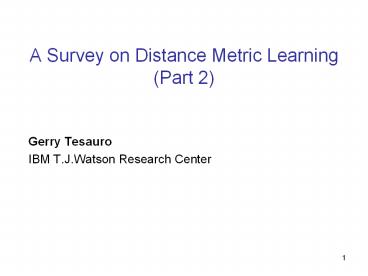A Survey on Distance Metric Learning (Part 2) - PowerPoint PPT Presentation
Title:
A Survey on Distance Metric Learning (Part 2)
Description:
Lecture material shamelessly adapted from the following sources: Kilian ... nearest neighbors in a heap-tree structure, update heap tree every 15 gradient steps ... – PowerPoint PPT presentation
Number of Views:37
Avg rating:3.0/5.0
Title: A Survey on Distance Metric Learning (Part 2)
1
A Survey on Distance Metric Learning (Part 2)
- Gerry Tesauro
- IBM T.J.Watson Research Center
2
Acknowledgement
- Lecture material shamelessly adapted from the
following sources - Kilian Weinberger
- Survey on Distance Metric Learning slides
- IBM summer intern talk slides (Aug. 2006)
- Sam Roweis slides (NIPS 2006 workshop on
Learning to Compare Examples) - Yann LeCun talk slides (CVPR 2005, 2006)
3
Outline Part 2
- Neighbourhood Components Analysis (Golderberger
et al.), Metric Learning by Collapsing Classes
(Globerson Roweis) - Metric Learning for Kernel Regression (Weinberger
Tesauro) - Metric learning for RL basis function
construction (Keller et al.) - Similarity learning for image processing (LeCun
et al.)
4
Neighborhood Component Analysis
Distance metric for visualization and kNN
(Goldberger et. al. 2004)
5
Metric Learning for Kernel Regression
Weinberger Tesauro, AISTATS 2007
6
Killing three birds with one stone
We construct a method for linear dimensionality
reduction
that generates a meaningful distance metric
optimally tuned for distance-based kernel
regression
7
Kernel Regression
- Given training set (xj , yj), j1,,N where x
is ?-dim vector and y is real-valued, estimate
value of a test point xi by weighted avg. of
samples - where kij kD (xi, xj) is a distance-based
kernel function using distance metric D
8
Choice of Kernel
- Many functional forms for kij can be used in
MLKR our empirical work uses the Gaussian
kernel - where s is a kernel width parameter (can set s1
W.L.O.G. since we learn D) - softmax regression estimate similar to Roweis
softmax classifier
9
Distance Metric for Nearest Neighbor Regression
Learn a linear transformation that allows to
estimate the value of a test point from its
nearest neighbors
10
Mahalanobis Metric
Distance function is a pseudo Mahalanobis metric
(Generalizes Euclidean distance)
11
General Metric Learning Objective
- Find parmaterized distance function D? that
minimizes total leave-one-out cross-validation
loss function - e.g. params ? elements Aij of A matrix
- Since were solving for A not M, optimization is
non-convex ? use gradient descent
12
Gradient Computation
- where xij xi xj
- For fast implementation
- Dont sum over all i-j pairs, only go up to 1000
nearest neighbors for each sample i - Maintain nearest neighbors in a heap-tree
structure, update heap tree every 15 gradient
steps - Ignore sufficiently small values of kij ( lt e-34
) - Even better data structures cover trees, k-d
trees
13
Learned Distance Metric example
orig. Euclidean D lt 1
learned D lt 1
14
Twin Peaks test
Training
n8000
we added 3 dimensions with 1000 noise
we rotated 5 dimensions randomly
15
Input Variance
Noise
Signal
16
Test data
17
Test data
18
Output Variance
Signal
Noise
19
DimReduction with MLKR
- FG-NET face data 82 persons, 984 face images
w/age
20
DimReduction with MLKR
- FG-NET face data 82 persons, 984 face images
w/age
21
DimReduction with MLKR
PowerManagement data (d21)
- Force A to be rectangular
- Project onto eigenvectors of A
- Allows visualization of data
22
Robot arm results (8,32dim)
regression error
23
Unity Data Center Prototype
- Objective Learn long-range resource value
estimates for each application manager - State Variables (48)
- Arrival rate
- ResponseTime
- QueueLength
- iatVariance
- rtVariance
- Action of servers allocated
- by Arbiter
- Reward SLA(Resp. Time)
Maximize Total SLA Revenue
5 sec
Demand (HTTP req/sec)
Demand (HTTP req/sec)
Value(srvrs)
Value(srvrs)
Value(srvrs)
SLA
SLA
SLA
Value(RT)
WebSphere 5.1
Value(srvrs)
WebSphere 5.1
Value(RT)
DB2
DB2
Trade3
Batch
Trade3
8 xSeries servers
(Tesauro, AAAI 2005 Tesauro et al., ICAC 2006)
24
Power Performance Management
- Objective Managing systems to multi-discipline
objectives minimize Resp. Time and minimize
Power Usage - State Variables (21)
- Power Cap
- Power Usage
- CPU Utilization
- Temperature
- of requests arrived
- Workload intensity ( Clients)
- Response Time
- Action Power Cap
- Reward SLA(Resp. Time) Power Usage
(Kephart et al., ICAC 2007)
25
IBM Regression Results TEST ERROR
MLKR
14/47
3/5
10/22
26
IBM Regression Results TRAINING ERROR
MLKR
27
Metric Learning for RL basis function
construction (Keller et al. ICML 2006)
- RL Dataset of state-action-reward tuples (si,
ai, ri) , i1,,N
28
Value Iteration
- Define an iterative bootstrap calculation
- Each round of VI must iterate over all states in
the state space - Try to speed this up using state aggregation
(Bertsekas Castanon, 1989) - Idea Use NCA to aggregate states
- project states into lower-dim rep keep states
with similar Bellman error close together - use projected states to define a set of basis
functions ? - learn linear value function over basis functions
V ? ?i ?i
29
Chopra et. al. 2005
Similarity metric for image verification.
Problem Given a pair of face-images, decide if
they are from the same person.
30
Chopra et. al. 2005
Similarity metric for image verification.
Problem Given a pair of face-images, decide if
they are from the same person.
Too difficult for linear mapping!
31
(No Transcript)































